Navigation
Simple Tool Helps Companies Address Water Risks
A global online tool launched today, March 28, 2012, by WWF and German development finance institution DEG (Deutsche Investitions-und Entwicklungsgesellschaft mbH) enables companies and investors to address their water-related risks. WWF and DEG have created a practical online questionnaire that not only identifies water risk in supply chains and investment portfolios, but also provides practical steps to mitigate risk.
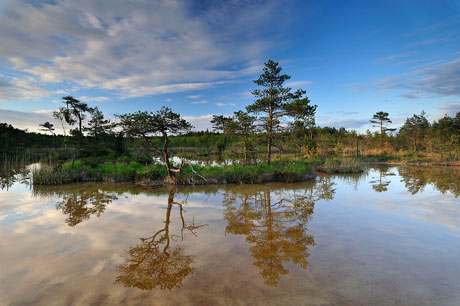 Hydrogen sulphide pond, Kemeri National Park, Latvia: Hydrogen sulphide (H2S) pond with trees reflected in water, Bog forest, Kemeri National Park, Latvia, June 2009. Photograph © Wild Wonders of Europe /Diego Lopez / WWF
Hydrogen sulphide pond, Kemeri National Park, Latvia: Hydrogen sulphide (H2S) pond with trees reflected in water, Bog forest, Kemeri National Park, Latvia, June 2009. Photograph © Wild Wonders of Europe /Diego Lopez / WWF
A global online tool launched today, March 28, 2012, by WWF and German development finance institution DEG (Deutsche Investitions-und Entwicklungsgesellschaft mbH) enables companies and investors to address their water-related risks. WWF and DEG have created a practical online questionnaire that not only identifies water risk in supply chains and investment portfolios, but also provides practical steps to mitigate risk.
Roughly 40 per cent of the world’s population lives in river basins that experience severe water scarcity during at least one month of the year; more than 900 million people lack access to safe drinking water and 2.7 billion lack access to basic sanitation services. Population growth and climate change are set to increase pressure on vital freshwater resources, with serious consequences for nature, people and economies.
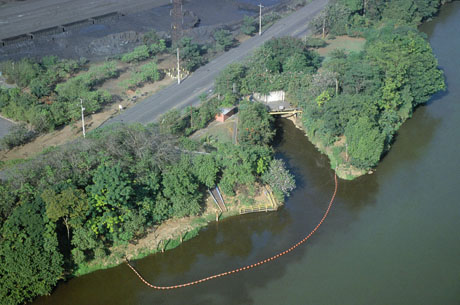 Rio de Janeiro, Brazil: Toxic effluent, from heavy industry and coal factory at Resende, poorly retained by inadequate boom. Forest-Water Interrelation in Protected Areas and No-Cutting Zones at the Paraiba do Sul River Basin Project, part of one of the WWF Freshwater projects sponsored by HSBC. Rio de Janeiro State, Brazil. Photograph© Edward Parker / WWF-Canon
Rio de Janeiro, Brazil: Toxic effluent, from heavy industry and coal factory at Resende, poorly retained by inadequate boom. Forest-Water Interrelation in Protected Areas and No-Cutting Zones at the Paraiba do Sul River Basin Project, part of one of the WWF Freshwater projects sponsored by HSBC. Rio de Janeiro State, Brazil. Photograph© Edward Parker / WWF-Canon
“Water scarcity is a concern for conservationists, communities and companies alike. But simply competing for every last drop will do no good to anyone. If water users become aware of their water risks – and work together to find solutions – we can ensure that people, nature and businesses have the water they need,” said Jim Leape, WWF International Director General.
A risk that cannot be ignored in business operations
Virtually every business sector relies on water. Yet many executives remain unaware of how water flows through their supply chains, or how the health of the environment where their facilities are located could affect long-term profitability.
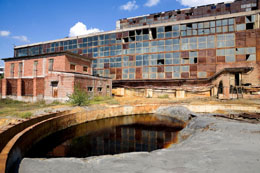 Chemicals in a basin, Moldomin steel-making factory, Romania: Chemicals in a basin, Moldomin steel-making factory, Danube River, Portile de Fier Nature Park, Romania. Photograph © Michel Gunther / WWF-Canon
Chemicals in a basin, Moldomin steel-making factory, Romania: Chemicals in a basin, Moldomin steel-making factory, Danube River, Portile de Fier Nature Park, Romania. Photograph © Michel Gunther / WWF-Canon
WWF and DEG’s message to companies is simple: Why take the risk? DEG has established water as a critical field for its client companies, and has used the Water Risk Filter to help them identify and mitigate water risk in business operations.
“Water availability is the most underestimated critical issue for the companies we are financing, but we believe that financial institutions can help make the companies more sustainable in their performance. Our work with WWF looks beyond the risks and shows practical ways how to change them into business opportunities,” said Bruno Wenn, Chairman of DEG.
What makes the tool unique?
The Water Risk Filter incorporates WWF’s science-based approach to water stewardship. It has a number of unique features:
It is easy to use. Geared specifically for non-experts, it guides users through a simple questionnaire and a pre-assessment survey that uses industry and geographic information to evaluate in less than 5 minutes if additional evaluation is necessary.
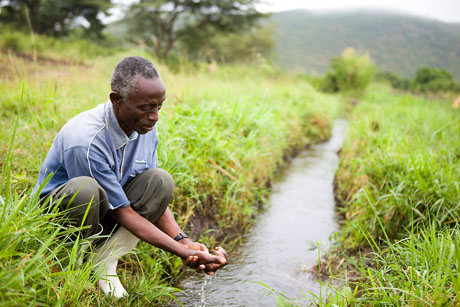 Water sourced from an irrigation project, Rwenzori Mountains, Uganda: Water sourced from an irrigation project, which diverts water from the river to farmland. Rwenzori Mountains, Uganda. Photograph© WWF-Canon / Simon Rawles
Water sourced from an irrigation project, Rwenzori Mountains, Uganda: Water sourced from an irrigation project, which diverts water from the river to farmland. Rwenzori Mountains, Uganda. Photograph© WWF-Canon / Simon Rawles
It is global and draws on data sheets for 235 countries and territories, providing interactive maps and case studies.
The tool uses the best available data as well as company specific information to analyse all relevant indicators of water risk.
The tool goes beyond an assessment and provides a mitigation toolbox for the user.
“The Water Risk Filter will undoubtedly identify water ‘red zones’ – those places where scarcity creates investment risk. The answer is not to abandon those places; from a practical standpoint this won’t be possible. Instead we must turn red to green and manage resources within scarcity,” said Stuart Orr, WWF Freshwater Manager.
Global fashion retailer H&M was among the companies to test the online tool.
“The outcomes from the Water Risk Filter are important inputs for our new, holistic water strategy that we are developing together with WWF. It shows us where and how we can have the biggest impact, and helps improve our understanding of how sustainable our supply chain is given the often difficult local water situations,” said Mikael Blomme, Environmental Sustainability Manager at H&M.
Ivo Mulder, Programme Officer, Biodiversity and Ecosystems/ Water and Finance of The United Nations Environment Programme (UNEP) welcomed the water risk filter and stressed the important role of risk assessment for companies in terms of competitiveness, reputation and investor confidence.
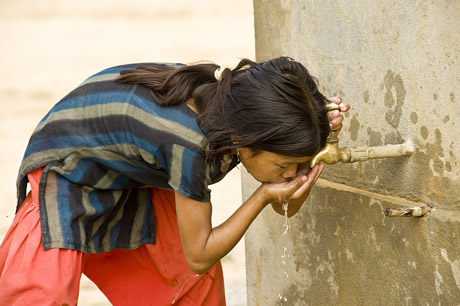 A girl drinking water from a tap that leads to a local spring. Through WWF funding (Under the TAL joint government and WWF proje: A girl drinking water from a tap that leads to a local spring. Through WWF funding (Under the TAL joint government and WWF project) and help from the local community (Community Forest Co-ordination Committee), many springs have been found in the area and are now set up to provide water to the local populace. Due to deforestation and soil erosion springs are vital in providing people with fresh, clean water. With more springs being used and trees being planted it is hoped that water levels will begin to rise once again. Lamahai, western Terai, Nepal. Photograph © Simon de TREY-WHITE / WWF-UK
A girl drinking water from a tap that leads to a local spring. Through WWF funding (Under the TAL joint government and WWF proje: A girl drinking water from a tap that leads to a local spring. Through WWF funding (Under the TAL joint government and WWF project) and help from the local community (Community Forest Co-ordination Committee), many springs have been found in the area and are now set up to provide water to the local populace. Due to deforestation and soil erosion springs are vital in providing people with fresh, clean water. With more springs being used and trees being planted it is hoped that water levels will begin to rise once again. Lamahai, western Terai, Nepal. Photograph © Simon de TREY-WHITE / WWF-UK
“For a long time, financial institutions have focused on climate change as the factor with the most material impact on loans, investments and insurance products. That landscape is changing quickly, with water emerging beyond reputational risk. It now holds the potential of affecting debt-servicing and the creditworthiness of clients. The Water Risk Filter helps financial institutions better understand and structure the different components of water risks, and assess these risks throughout the due diligence processes,” Mulder said.
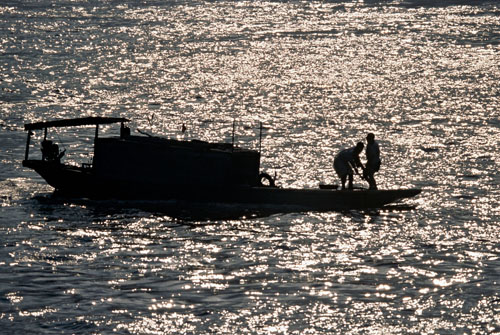 Yangtze River, China: Traditional fishing boat on the Yangtze River, Hubei Province, China. Photograph © Michel Gunther / WWF-Canon
Yangtze River, China: Traditional fishing boat on the Yangtze River, Hubei Province, China. Photograph © Michel Gunther / WWF-Canon
The Water Risk Filter is available at http://www.waterriskfilter.panda.org/
About the Water Risk Filter, an evolving tool
Water is becoming a hot topic for business, yet most companies don’t know where to start in understanding and responding to water issues. This tool is designed to help companies and investors to ask the right questions about water - to assess risks and give guidance on what to do in response. The Water Risk Filter is designed to be easy to use, yet highly robust in the results that are generated. We want to enable users to plan and create strategies for their own company, suppliers or investments to drive down risk and become proactive in responding to water issues they face - and by doing so, become better water stewards.
For WWF and DEG, estimating the perfect risk score is not the end goal. The scores are instead the best and most accurate reflection of the multiple issues that companies face around water and should guide a company into a position of proactive engagement on water. We believe that by generating interest and guidance on water actions, we can improve how water is managed, measured and improved for society, the economy and the environment.
This tool is evolving
Please support the further development with:
- your voluntary financial contributions
- your case studies and mitigation responses
- suggestions for better underlying data source
Frequently asked questions
Why should I use the Water Risk Filter?
It’s too easy not to do. Designed for non-water experts, this tool provides a highly structured set of risk indicators with very limited information needed from you. The Water Risk Filter covers all relevant elements of water risks, all industries (standard classifications) and all countries of the world. It interprets the best available scientific data for you and translates it into risk numbers based on the questionnaire. Then, you can map your assessed facilities or investments on numerous water related map overlays. Finally, a structured set of responses and up-to-date case studies will give you a flying start in mitigating risk and developing a water stewardship strategy.
Other questions answered on this page are:
When should I use the Water Risk Filter?
Is this another separate water tool?
What is the difference with other water tools?
What is the connection with the Alliance for Water Stewardship?
Will it take much of my time?
Has the Water Risk Filter been tested?
Are the risk methodology and the used underlying data sources sound?
Does the Water Risk Filter assess business risks for the user, or risks for the ecosystem?
Is my data secured?
Is WWF or DEG able to use your data?
Is long term maintenance of the Water Risk Filter secured?
This news is from WWF and DEG 28 March 2012.
Search
Latest articles
Agriculture
- World Water Week: Healthy ecosystems essential to human health: from coronavirus to malnutrition Online session Wednesday 24 August 17:00-18:20
- World Water Week: Healthy ecosystems essential to human health: from coronavirus to malnutrition Online session Wednesday 24 August 17:00-18:20
Air Pollution
- "Water and Sanitation-Related Diseases and the Changing Environment: Challenges, Interventions, and Preventive Measures" Volume 2 Is Now Available
- Global Innovation Exchange Co-Created by Horizon International, USAID, Bill and Melinda Gates Foundation and Others
Biodiversity
- It is time for international mobilization against climate change
- World Water Week: Healthy ecosystems essential to human health: from coronavirus to malnutrition Online session Wednesday 24 August 17:00-18:20
Desertification
- World Water Week: Healthy ecosystems essential to human health: from coronavirus to malnutrition Online session Wednesday 24 August 17:00-18:20
- UN Food Systems Summit Receives Over 1,200 Ideas to Help Meet Sustainable Development Goals
Endangered Species
- Mangrove Action Project Collaborates to Restore and Preserve Mangrove Ecosystems
- Coral Research in Palau offers a “Glimmer of Hope”
Energy
- Global Innovation Exchange Co-Created by Horizon International, USAID, Bill and Melinda Gates Foundation and Others
- Wildlife Preservation in Southeast Nova Scotia
Exhibits
- Global Innovation Exchange Co-Created by Horizon International, USAID, Bill and Melinda Gates Foundation and Others
- Coral Reefs
Forests
- NASA Satellites Reveal Major Shifts in Global Freshwater Updated June 2020
- Global Innovation Exchange Co-Created by Horizon International, USAID, Bill and Melinda Gates Foundation and Others
Global Climate Change
- It is time for international mobilization against climate change
- It is time for international mobilization against climate change
Global Health
- World Water Week: Healthy ecosystems essential to human health: from coronavirus to malnutrition Online session Wednesday 24 August 17:00-18:20
- More than 400 schoolgirls, family and teachers rescued from Afghanistan by small coalition
Industry
- "Water and Sanitation-Related Diseases and the Changing Environment: Challenges, Interventions, and Preventive Measures" Volume 2 Is Now Available
- Global Innovation Exchange Co-Created by Horizon International, USAID, Bill and Melinda Gates Foundation and Others
Natural Disaster Relief
- STOP ATTACKS ON HEALTH CARE IN UKRAINE
- Global Innovation Exchange Co-Created by Horizon International, USAID, Bill and Melinda Gates Foundation and Others
News and Special Reports
- World Water Week: Healthy ecosystems essential to human health: from coronavirus to malnutrition Online session Wednesday 24 August 17:00-18:20
- STOP ATTACKS ON HEALTH CARE IN UKRAINE
Oceans, Coral Reefs
- World Water Week: Healthy ecosystems essential to human health: from coronavirus to malnutrition Online session Wednesday 24 August 17:00-18:20
- Mangrove Action Project Collaborates to Restore and Preserve Mangrove Ecosystems
Pollution
- Zakaria Ouedraogo of Burkina Faso Produces Film “Nzoue Fiyen: Water Not Drinkable”
- "Water and Sanitation-Related Diseases and the Changing Environment: Challenges, Interventions, and Preventive Measures" Volume 2 Is Now Available
Population
- "Water and Sanitation-Related Diseases and the Changing Environment: Challenges, Interventions, and Preventive Measures" Volume 2 Is Now Available
- "Water and Sanitation-Related Diseases and the Changing Environment: Challenges, Interventions, and Preventive Measures" Volume 2 Is Now Available
Public Health
- Honouring the visionary behind India’s sanitation revolution
- Honouring the visionary behind India’s sanitation revolution
Rivers
- World Water Week: Healthy ecosystems essential to human health: from coronavirus to malnutrition Online session Wednesday 24 August 17:00-18:20
- Mangrove Action Project Collaborates to Restore and Preserve Mangrove Ecosystems
Sanitation
- Honouring the visionary behind India’s sanitation revolution
- Honouring the visionary behind India’s sanitation revolution
Toxic Chemicals
- "Water and Sanitation-Related Diseases and the Changing Environment: Challenges, Interventions, and Preventive Measures" Volume 2 Is Now Available
- Actions to Prevent Polluted Drinking Water in the United States
Transportation
- "Water and Sanitation-Related Diseases and the Changing Environment: Challenges, Interventions, and Preventive Measures" Volume 2 Is Now Available
- Urbanization Provides Opportunities for Transition to a Green Economy, Says New Report
Waste Management
- Honouring the visionary behind India’s sanitation revolution
- Honouring the visionary behind India’s sanitation revolution
Water
- Honouring the visionary behind India’s sanitation revolution
- Honouring the visionary behind India’s sanitation revolution
Water and Sanitation
- Honouring the visionary behind India’s sanitation revolution
- Honouring the visionary behind India’s sanitation revolution

